I always carry another camera attached to my 100-400mm lens in my pickup no matter where I go and sometimes it pays off. Doing so allowed me to get this unexpected ten image series that I think is quite interesting.
Late yesterday morning as I was driving through my neighborhood on my way to the grocery store I spotted a clump in the road that turned out to be a Cooper’s Hawk on top of a freshly-killed pigeon. I had to do some fancy maneuvering of my pickup to get an angle on the birds with decent light and still be safe shooting from the road (I didn’t want to block any traffic that might come along).
I only had about 5 seconds with them before the hawk took off but I think they were a productive 5 seconds.
1/2000, f/7.1, ISO 320, Canon 7D Mark II, Canon EF 100-400mm f/4.5-5.6L IS II USM @ 400mm, not baited, set up or called in
By the time I got focused on them the hawk had already decided that it was going to vamoose with the pigeon and was apparently trying to figure out where to grasp it with its talons for the aerial hauling job ahead. An adult pigeon is large prey for a Cooper’s Hawk and it wouldn’t be an easy task to take off and fly with it.
I had no qualms about disturbing the bird and making it move the prey because I was concerned for its safety on the road. As I drove past it to get to the other side for good light I was within about 15′ of it and it didn’t fly. This was a recipe for disaster if someone came speeding by, as they sometimes do on this road.
1/2000, f/7.1, ISO 320, Canon 7D Mark II, Canon EF 100-400mm f/4.5-5.6L IS II USM @ 400mm, not baited, set up or called in
The hawk quickly decided where it wanted to grasp the pigeon with its talons and…
1/1600, f/7.1, ISO 320, Canon 7D Mark II, Canon EF 100-400mm f/4.5-5.6L IS II USM @ 400mm, not baited, set up or called in
gave me one last look before…
1/1600, f/7.1, ISO 320, Canon 7D Mark II, Canon EF 100-400mm f/4.5-5.6L IS II USM @ 400mm, not baited, set up or called in
attempting to take off with its heavy load.
1/2000, f/7.1, ISO 320, Canon 7D Mark II, Canon EF 100-400mm f/4.5-5.6L IS II USM @ 400mm, not baited, set up or called in
It got the pigeon into the air…
1/2000, f/7.1, ISO 320, Canon 7D Mark II, Canon EF 100-400mm f/4.5-5.6L IS II USM @ 400mm, not baited, set up or called in
but only made it about a foot off the pavement before it lost its grip on the heavy pigeon and dropped it.
1/2000, f/7.1, ISO 320, Canon 7D Mark II, Canon EF 100-400mm f/4.5-5.6L IS II USM @ 400mm, not baited, set up or called in
The pigeon fell through the air (I thought the flying drop of blood was pretty unique)…
1/2000, f/7.1, ISO 320, Canon 7D Mark II, Canon EF 100-400mm f/4.5-5.6L IS II USM @ 400mm, not baited, set up or called in
and fell back to the pavement. The hawk landed in a nearby tree and tried to decide what its next move might be.
At this point I decided to move my pickup further away from the pigeon so the hawk would be more likely to retrieve it. But as I was doing so the Cooper’s flew in, grabbed the pigeon and took off with it. It was so heavy it had great difficulty gaining any elevation – it barely cleared a 4′ chain link fence in the front yard of one of the houses and landed with the pigeon on the lawn. At that point a lady walking with her toddler granddaughter walked right by the fence. This flushed the hawk back into the tree and the pigeon…
1/1000, f/5.6, ISO 640, Canon 7D Mark II, Canon EF 100-400mm f/4.5-5.6L IS II USM @ 400mm, not baited, set up or called in
was left on the lawn.
1/3200, f/5.6, ISO 640, Canon 7D Mark II, Canon EF 100-400mm f/4.5-5.6L IS II USM @ 400mm, not baited, set up or called in
Here’s the hawk in the tree.
The lady and her granddaughter walked by twice but as they were approaching a third time the hawk swooped in, grabbed the pigeon and flew off with it between neighborhood houses. I missed the shots of the retrieval because the fence was in the way.
It was an exciting beginning to my trip to the grocery store. Some friends might think I’m a little weird because I always have that backup camera with me. So be it.
I got the shots so I’ll gladly pay that “weirdness” price.
Ron


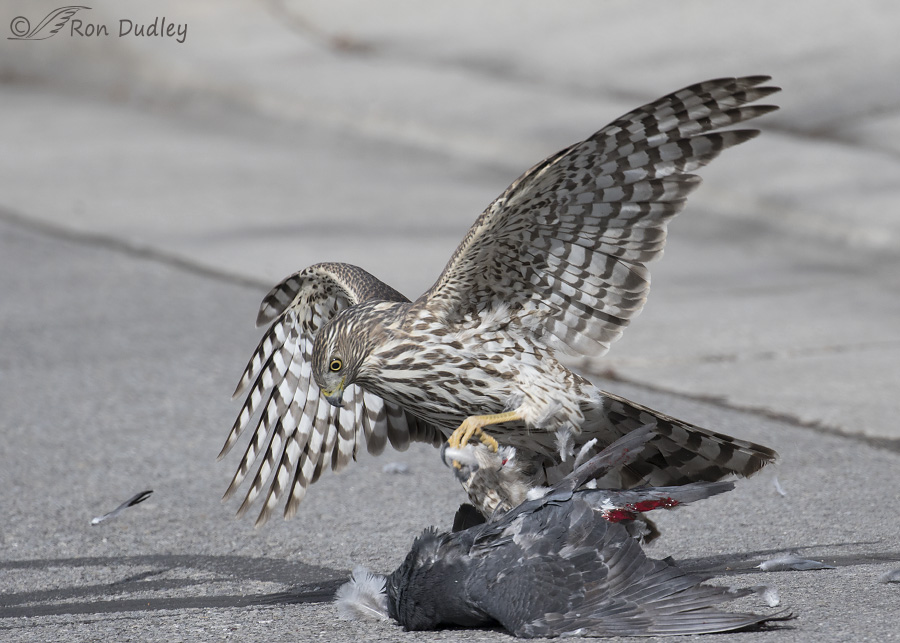
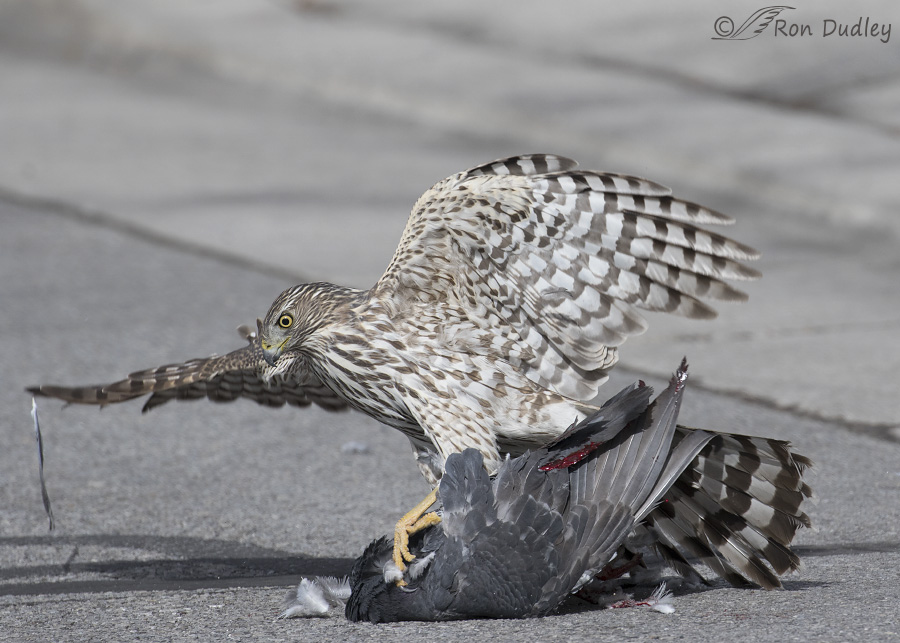
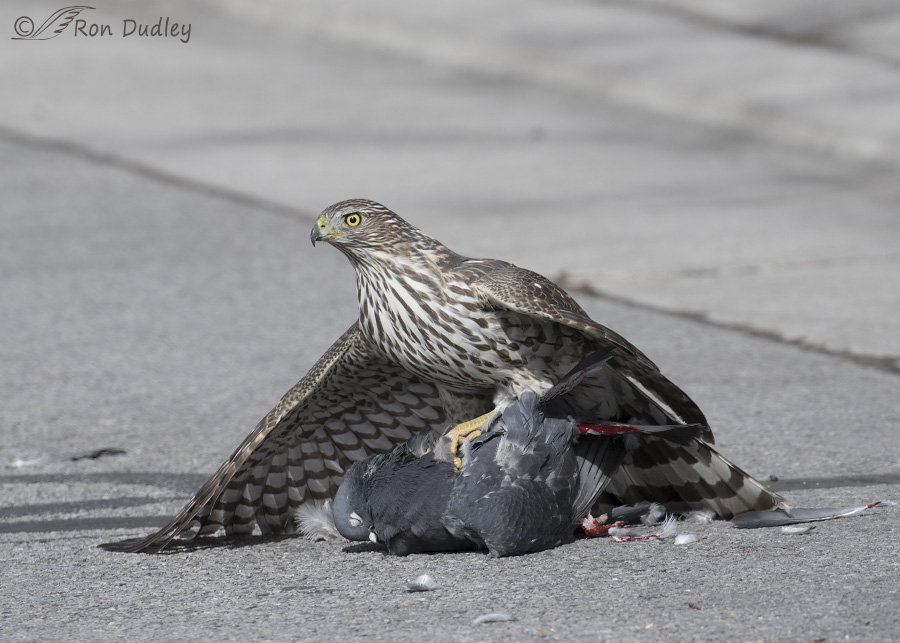
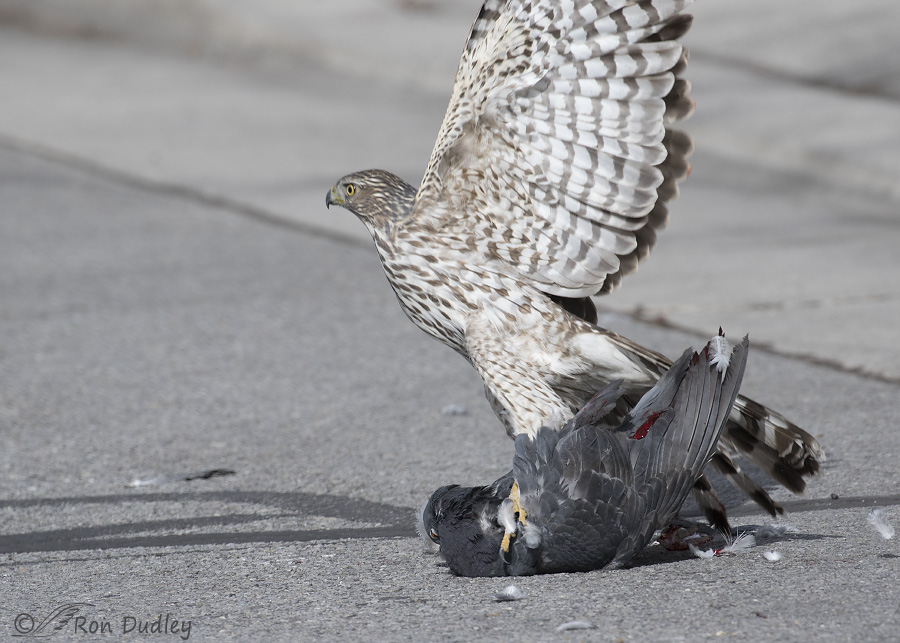
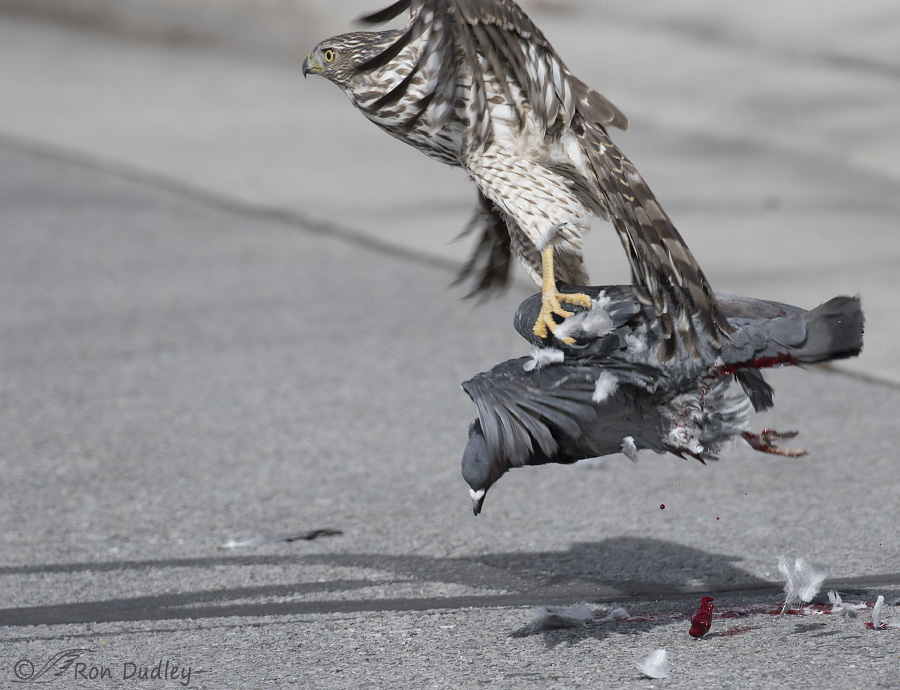
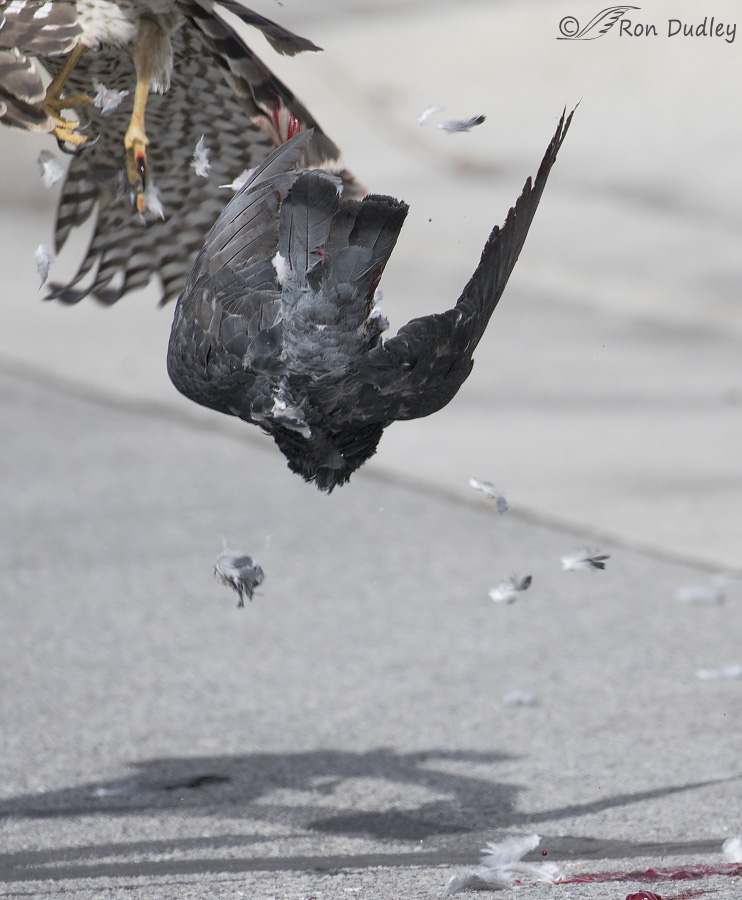
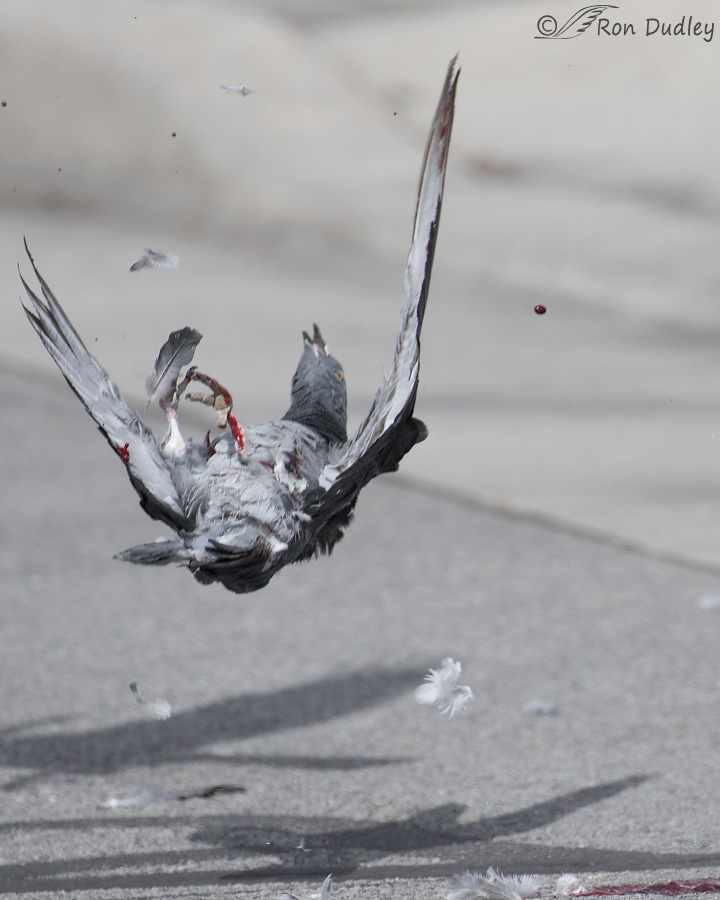
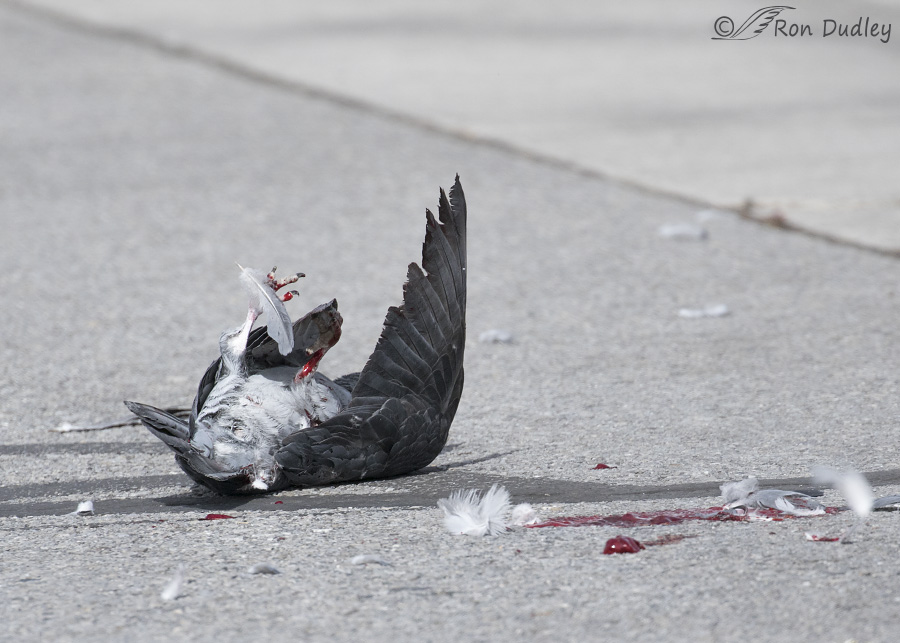
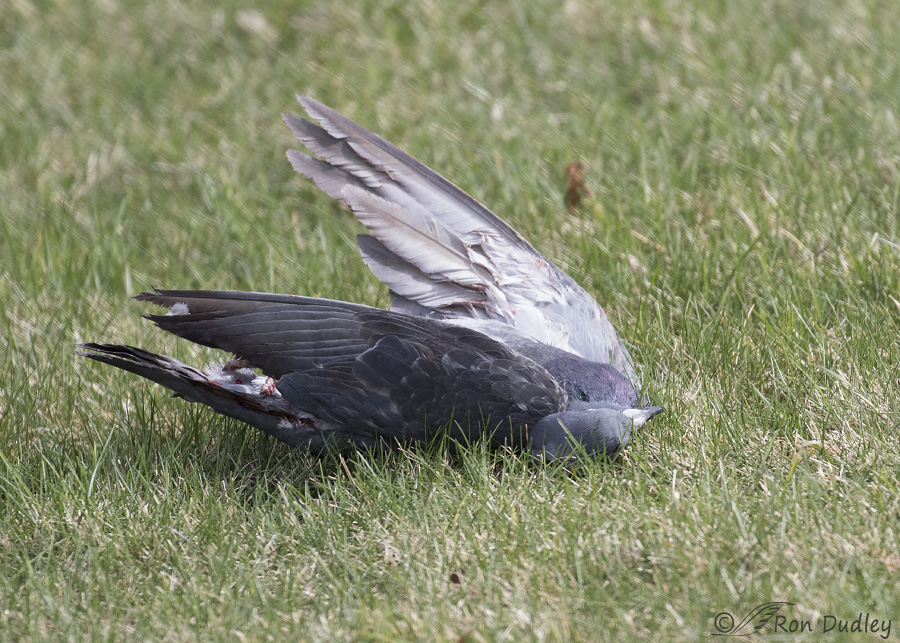
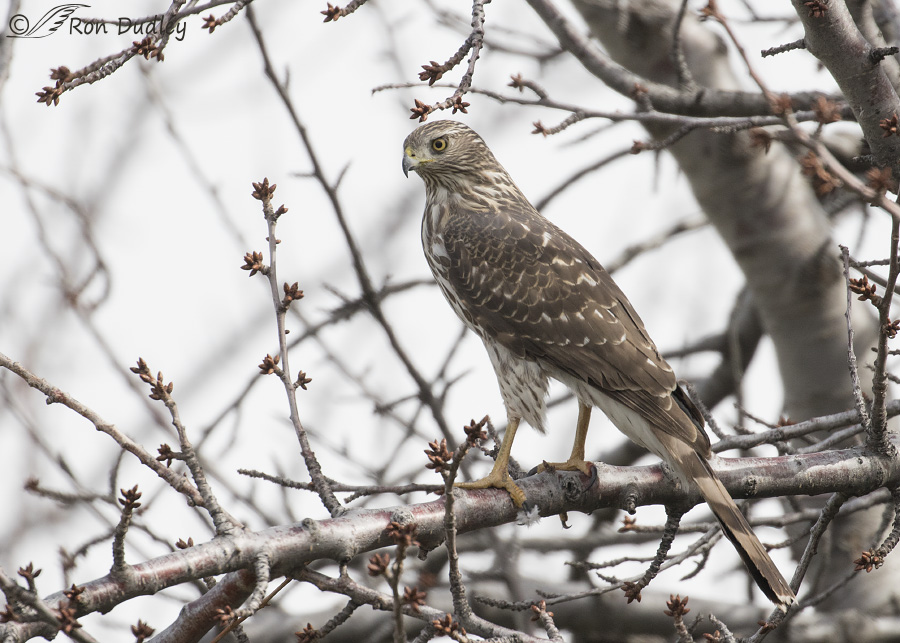
Great shots. It’s nice to see what someone who knows what he’s doing can do with the 100-400 mm lens. That last portait of the hawk is a killer!
Wow! I am totally awed by your shots Ron!
Charlotte
Weird? Not on that count.
I still (close to a decade later) regret not having a camera with me when we drove past a wedge-tailed eagle perched on a road killed roo.
And you would have the images – and not just in the dusty corridors of your mind.
Loved the series. Thank you.
But I have many other counts in that regard, don’t I, EC? I’m a actually proud of one or two of them but then there’s all the others…
Trust me Ron, weird is good
What an interesting series and story, and also ensuing discussion! Thanks everyone for additional clarification on the Cooper’s/Sharpie dilemma. It’s one I face every time I encounter a Cooper’s (or Sharpie). Ron, on this statement: “Some friends might think I’m a little weird because I always have that backup camera with me. So be it.” I know many of us relate. I had one Peregrine event that caused me to also “carry” wherever I go. I made a quick stop at Fred Meyer in Seattle, no camera. That day, there just happened to be a Peregrine chasing pigeons in the parking lot, and stopping every once in a while right near my car. Thankfully, I didn’t witness any carnage because you know how I feel about our pigeon folk. But, I would have had interesting shots of a Peregrine in pursuit. I never did see another Peregrine near that spot in the entire five years we lived there, despite hauling my camera to Fred Meyer every time after that. Luckily, nowadays my Oly mirrorless is small enough to put in a regular shoulder bag.
Ha, that part about taking your camera to Fred Meyer every time you went for five years made me laugh, Ingrid. We’re kindred spirits!
Serendipity strikes again — and you know enough to be prepared to catch it! That’s the mark of a true professional. Thank you for getting the pair off the street. I’m not sure I would have been as patient as you were with the lady and her charge. But I’m obnoxious like that sometimes. OK, most of the time.
That’s the mark of a true professional. Thank you for getting the pair off the street. I’m not sure I would have been as patient as you were with the lady and her charge. But I’m obnoxious like that sometimes. OK, most of the time.
This series brings a new definition to the term “pigeon drop.” I feel a little bad for the old boy; all the ruckus adding insult to (fatal) injury. These are some incredible shots of life in the urban jungle, though.
Love this comment, Marty.
Thank you, Ingrid.
Thanks, Marty. I wasn’t patient with that lady. I was seething inside. But there wasn’t much (constructive) I could do about the situation.
Besides, she was talking to the little girl in German (I think) and I figured we might have a communication problem in more ways than one.
Marty, obnoxious isn’t always a bad thing when protecting critters (mostly predators) from well-meaning humans or even those who are just plain stupid. I tend to practice obnoxity when appropriate And no, you won’t find that word in the dictionary! I made it up.
And no, you won’t find that word in the dictionary! I made it up.
Never ever go anywhere without a camera !!!!!!!Thats when you miss phenomenal shots like this !!
Yup!
Great capture. See those rock doves and ring neck doves are good for something.
Thank you, April.
I’ve often been struck by the sharpness of your photos, despite the action happening, and always look to confirm that you are, indeed, shooting at very high shutter speed more often than not. The drop of blood is superb and further evidence of the benefits of going that route. Many photographers shy away from this in order to get greater depth of field or more light, but these shots should be encouraging to all to experiment.
Kath, You’re right, overall, for the type of shooting I do, I often prefer relatively high shutter speeds.
First of all, weird is good! Far, FAR better than normal
Secondly, OH WOW! It’s not often you can serendipitously find a Cooper’s hawk on prey! And to get that series of photos, well, yet again, OH WOW my friend. And you know how much I love seeing raptors with a) a full crop or b) on a nice-meal kind of kill. That Cooper’s worked hard to catch that pigeon and I’m delighted that she got away with it to dine in peace.
And let me add to what Louise said. Agreed that it’s a juvie female Cooper’s–a male couldn’t have managed that feat. And thank you for protecting that Cooper’s. I continually celebrate your integrity in the field!
You said it all, Laura…amen!!!
You’re right, Laura – this was only the second time I’ve come across a Cooper’s on prey (up close). Pretty exciting!
Often referred to as a Nat. Geo. moment. Forget that…a Dudley moment. Awesome.
Thanks very much, Susan.
How exciting!! I don’t think its a bit weird to have a backup camera at all!! I missed wild mustangs engaging in a battle because my media card screwed up and my brand new camera froze. Wish I’d had a second camera!! I truly enjoyed this series – I love “behind the scene captures!”
Linda, I actually have two DSLR’s in my pickup (besides the one attached to my 500mm when it’s with me). Plus a video cam. Plus my phone camera. I’ll plead guilty to being a little weird…
A productive 5 seconds, indeed! I love the tiny little pigeon feather stuck on the talon of the hawk’s left foot- a little evidence from the scene of the crime!
Good eye, Diane. I’ll bet not many folks noticed that feather.
Size, shape of tsil, legs??? How did you decide it was a Coopers? I’m beginning to think my goal of being the world’s foremost authority on telling Cooper from Sharp-shinned is being unrealistic….at 84 I’m running out ot time..(Jerry Liguori gets the first, signed, copy, but you and Mia will get the next two)..,,
Patty, see my answer to Dan Sedenquist’s question below.
That is an incredible series!!! So glad you had your ” ball and chain ” with you and were abke to capture it! As my camera “got heaviervand heavier “–or seemed to, I sometimes felt it was like a ball and chain, because I was obsessive about lugging it any and everywhere I went. With its heavy zoom, it helped do a job on an already bad back. I finally gave it to my 6’3″” grsndson and got a nice, light (mediocre) point and shoot. Most of my photohgraphy is for reference only.even so, I always carry a backup, too. I wonder if that lady with the baby had idea of the drsma she was interrupting…or was completely obvivious. So much goes on right under our noses!!!
Patty, That “lady” knew exactly what was going on – she clearly saw both the hawk with the pigeon and me aiming my lens at it. But she didn’t give a damn and still walked to within a few feet of the back of my pickup. Twice! I was not happy with her…
Excellent! Excellent! Excellent! Ron, I thought you deserved at least three “Excellents!” for this superb series as well as the accompanying story-telling. A wonderful treat for this morning! Thank you!
Thanks, thanks and thanks, Den!
I usually struggle to identify Coopers vs. Sharp-shinned hawks. Why did you land on Cooper’s for this one? Wonderful series of images.
This bird looks like a female Coopers because of the long dark breast streaks and the rounded tail, visible in the last image. Excellent photos, Ron. We often don’t get the opportunity to see these details when we are out in nature. Thank you, again.
Why is nobody wondering about the pigeon here? he is the victim, not the perp! Like people, sometimes!
Judy – Just FYI, this is an immature Coopers Hawk. There is no color or marking dimorphism between male and female, just a tremendous difference in size – but a definite color difference between juvies and adults (eye color, too). I would guess that it’s a female because the average male weighs considerably less than the normal pigeon. And, Dan, Sharp-shins are considerably smaller yet, with a male weighing on average about the same as a male kestrel (about 105 g). The thickness of the legs (sharpies’ legs are like matchsticks), the size of the head in relation to the body, and the fact that it could kill and lift, especially from a standing start, a pigeon definitely screams Coopers. Ron – Thanks for getting him out of the road! That bird was determined to have its meal!
Whoops! I was so excited about the action Ron captured that I forgot to look at details of plumage and the eye color. I hope this impressive female makes it to breeding age.
Louise Shimmel, just catching up on all Ron’s post for the week. Thank you for posting the links to your Rehabilitation Article. I remember reading it a number of years ago and enjoyed reading it again. Well written article, thank you.
Louise Shimmel ROCKS! Just in case any of you didn’t know that.
Agreed, Laura!
Thanks for providing all that interesting information, Louise. And for the ID confirmation.
Dan, I often struggle with ID of Cooper’s and Sharp-shinned too. But in this case I leaned strongly toward Cooper’s mostly because of its size. But I wanted to confirm it so last night I sent two of these images to my friend and raptor ID expert Jerry Liquori. When Jerry positively ID’s a raptor I’d bet the bank that he’s right and he said it’s a Cooper’s.
Great set!! Great to have a camera with you!
Wow!
Thanks, Judy.
Perhaps there are eggs to lay or a feeding plan for chicks or a mate on nest. According to the chart I use while working on the Wisconsin Breeding Bird Atlas II, Cooper’s here could be either breeding or migrating at this time. The chart is based on the first WI atlas; the data was gathered from 1995 – 2000.
Since the hawk was big enough to kill a pigeon, egg laying might make the most sense concerning eating a great deal.
Your speculations sound plausible to me, Pam.
Backup camera with you most of the time – weird? No, smart. “You miss 100% of the shots you don’t take,”
Even against asphalt, the flying drop of blood reflects awfully good photography.
Thank you for a very interesting series.
I’m glad you enjoyed it, Richard. Thanks.
Thanks for the wonderful sequence and for making sure the COHA was out of harms way from motor vehicles. Thanks for pointing out the birds crop. I missed that. Of course I often miss lots that you see for all of us.
Again wonderful series. Diana
I think that bird’s getting plenty to eat, Diana. There’s a bunch of pigeons that roost on light poles in the neighborhood – probably easy pickin’s for the hawk.
Nothing (well, almost nothing) is “easy pickin’s.” They have to work hard for each and every meal and they put their lives on the line for each calorie. I so admire raptors (I know that comes as a surprise to some of you…LOL!)
I believe every predator puts its life on the line for calories. I find it surprising that folks vilify them for “harvesting” their food.
A broken talon, claw or tooth, a bone injury from prey and many other outcomes of the struggle as life feeds on life often results in a predator that is lucky to heal and prey again. That kind of record is clearly illustrated in the fossil record of theropod dinosaurs, such as Sue of the Field Museum.
Pam as a falconer, I’ve seen up close and personal how dangerous a raptor’s life is. There are dangers everywhere, many of them human inspired. Survival is not an easy task in The Great Out There and is a continual life-and-death struggle for predator and prey.
That said, I’ve also seen their outrageous power. The math just doesn’t work for a little 600-gram male Harris’ hawk to take down a seven- to nine-pound jackrabbit–and yet, they do. I wonder how long today’s humans would survive if we had to work THAT hard for our lunch?
This story is the perfect example of why one should always have a camera with them. Absolutely wonderful series, and I’m glad you were able to catch it. (Note, I’ll see you in a couple of months – we’ll be traveling – I’ll miss seeing the blog and everyone here.)
Have a good trip!!!
Have a great time, Susan!
Cool! Good fortune to have the camera with you and the action in the middle of the street. The hawk certainly had a huge load to haul – amazing it could manage it! That meal should have kept it happy for awhile and replenished the energy used to kill and haul it. Appears there are several smaller flying drops of blood also.
The hawk certainly had a huge load to haul – amazing it could manage it! That meal should have kept it happy for awhile and replenished the energy used to kill and haul it. Appears there are several smaller flying drops of blood also. 
Judy, I think that Cooper’s is well-fed. It had barely started to eat the pigeon but it looks to me like it’s crop was already bulging a little.